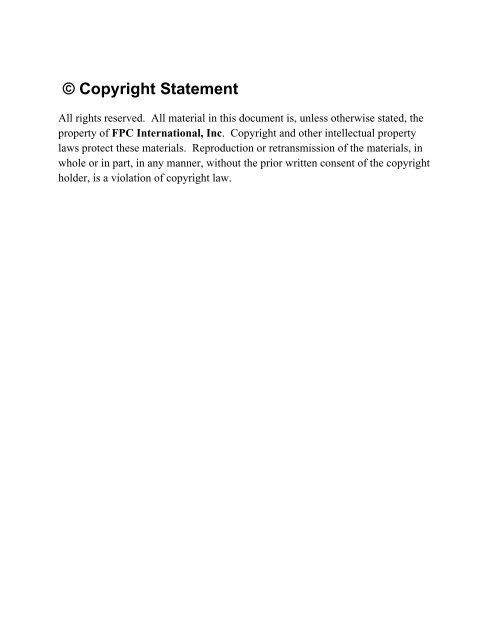© Copyright Statement
© Copyright Statement - Fpc1.com
© Copyright Statement - Fpc1.com
- No tags were found...
Create successful ePaper yourself
Turn your PDF publications into a flip-book with our unique Google optimized e-Paper software.
<strong>©</strong> <strong>Copyright</strong> <strong>Statement</strong><br />
All rights reserved. All material in this document is, unless otherwise stated, the<br />
property of FPC International, Inc. <strong>Copyright</strong> and other intellectual property<br />
laws protect these materials. Reproduction or retransmission of the materials, in<br />
whole or in part, in any manner, without the prior written consent of the copyright<br />
holder, is a violation of copyright law.
UHI TECHNICAL BULLETIN January 1993<br />
THE BIOCIDAL ACTIVITY<br />
OF FPC-l®<br />
Microbial growth in distillate fuels can be a significant problem to diesel fleet operators. The<br />
microbial colonies propagate at the fuel-water interface and, if fuel water can be totally<br />
eliminated, the problem of microbial growth is also eliminated. However, total elimination of<br />
water is difficult to obtain in practice.<br />
One of the active components of FPC-l ® Fuel Performance Catalyst is a recognized antimicrobial<br />
agent (phenol coefficient = 6). At the recommended mixing ratio (1 part FPC-l ®/5000<br />
parts fuel), fuel treated with FPC-l ® contains approximately 5 parts per million (ppm) of this<br />
biocide.<br />
Laboratory tests on simulated samples and filters used in the field show the biocide in FPC-1 ®<br />
concentrates in any water present in the fuel and/or filter, and can attain levels that eradicate<br />
microbial colonies. Once the microbes are killed, the same chemical becomes a biostat,<br />
preventing renewed propagation of microbial colonies in the fuel system. The concentration of<br />
the biocide ingredient in FPC-l ® taken from filters and submitted for analysis was in the range of<br />
75 ppm to 300 ppm, depending upon the water content of the filter.<br />
A recent report demonstrates the effect of the biocide under controlled laboratory conditions.<br />
Three aqueous solutions containing 88, 176, and 294 ppm of the FPC-l@ biocide were made up<br />
and tested for biocidal effectiveness. These concentrations correspond to the probable range of<br />
biocide accumulation encountered in actual practice.<br />
Samples of distilled water were inoculated with bacteria and treated with varying amounts of the<br />
FPC-l ® biocide ingredient. The results are tabled below:<br />
Sample<br />
Control Sample A<br />
Control Sample B<br />
Control Sample A*<br />
Control Sample B*<br />
Test Sample 1 A*<br />
Test Sample 1 B*<br />
Test Sample 2 A *<br />
Test Sample 2 B*<br />
Test Sample 3 A *<br />
Test Sample 3 B*<br />
Biocide PPM<br />
o<br />
ooo<br />
88<br />
88<br />
176<br />
176<br />
294<br />
294<br />
Total Bacteria/ml<br />
8200<br />
8300<br />
8800<br />
9500<br />
720<br />
630<br />
1<br />
o<br />
1<br />
.After one hour of contact, solution plated, incubated and reading taken.<br />
UHI CORPORATION 2230 N. University Parkway. Suite 5B. Provo. Utah 84604<br />
Phone (SOl) 374·9010 Fax ISIlI) 374-()~45






